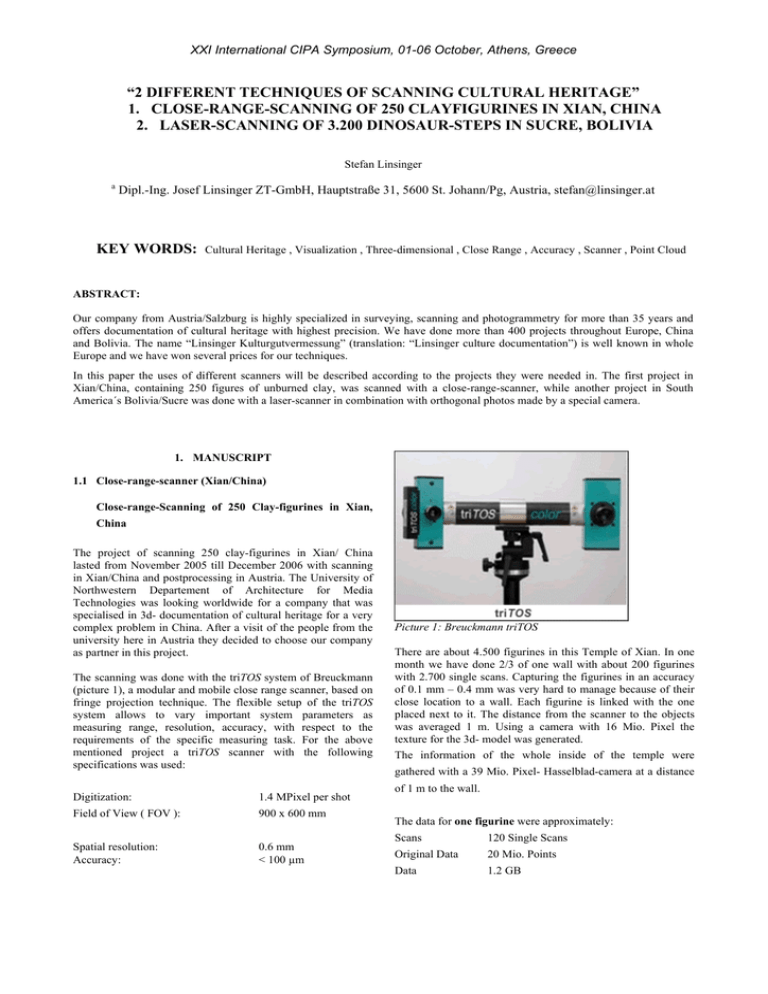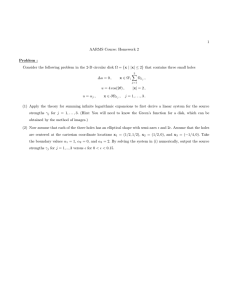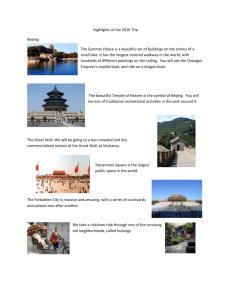“2 DIFFERENT TECHNIQUES OF SCANNING CULTURAL HERITAGE”
advertisement

XXI International CIPA Symposium, 01-06 October, Athens, Greece “2 DIFFERENT TECHNIQUES OF SCANNING CULTURAL HERITAGE” 1. CLOSE-RANGE-SCANNING OF 250 CLAYFIGURINES IN XIAN, CHINA 2. LASER-SCANNING OF 3.200 DINOSAUR-STEPS IN SUCRE, BOLIVIA Stefan Linsinger a Dipl.-Ing. Josef Linsinger ZT-GmbH, Hauptstraße 31, 5600 St. Johann/Pg, Austria, stefan@linsinger.at KEY WORDS: Cultural Heritage , Visualization , Three-dimensional , Close Range , Accuracy , Scanner , Point Cloud ABSTRACT: Our company from Austria/Salzburg is highly specialized in surveying, scanning and photogrammetry for more than 35 years and offers documentation of cultural heritage with highest precision. We have done more than 400 projects throughout Europe, China and Bolivia. The name “Linsinger Kulturgutvermessung” (translation: “Linsinger culture documentation”) is well known in whole Europe and we have won several prices for our techniques. In this paper the uses of different scanners will be described according to the projects they were needed in. The first project in Xian/China, containing 250 figures of unburned clay, was scanned with a close-range-scanner, while another project in South America´s Bolivia/Sucre was done with a laser-scanner in combination with orthogonal photos made by a special camera. 1. MANUSCRIPT 1.1 Close-range-scanner (Xian/China) Close-range-Scanning of 250 Clay-figurines in Xian, China The project of scanning 250 clay-figurines in Xian/ China lasted from November 2005 till December 2006 with scanning in Xian/China and postprocessing in Austria. The University of Northwestern Departement of Architecture for Media Technologies was looking worldwide for a company that was specialised in 3d- documentation of cultural heritage for a very complex problem in China. After a visit of the people from the university here in Austria they decided to choose our company as partner in this project. The scanning was done with the triTOS system of Breuckmann (picture 1), a modular and mobile close range scanner, based on fringe projection technique. The flexible setup of the triTOS system allows to vary important system parameters as measuring range, resolution, accuracy, with respect to the requirements of the specific measuring task. For the above mentioned project a triTOS scanner with the following specifications was used: Digitization: 1.4 MPixel per shot Field of View ( FOV ): 900 x 600 mm Spatial resolution: Accuracy: 0.6 mm < 100 µm Picture 1: Breuckmann triTOS There are about 4.500 figurines in this Temple of Xian. In one month we have done 2/3 of one wall with about 200 figurines with 2.700 single scans. Capturing the figurines in an accuracy of 0.1 mm – 0.4 mm was very hard to manage because of their close location to a wall. Each figurine is linked with the one placed next to it. The distance from the scanner to the objects was averaged 1 m. Using a camera with 16 Mio. Pixel the texture for the 3d- model was generated. The information of the whole inside of the temple were gathered with a 39 Mio. Pixel- Hasselblad-camera at a distance of 1 m to the wall. The data for one figurine were approximately: Scans 120 Single Scans Original Data 20 Mio. Points Data 1.2 GB XXI International CIPA Symposium, 01-06 October, Athens, Greece The result was a 3d- model from the outside and inside, facades, sections and ground-floors and the 3d-close-range-scan from the figurines of one wall inside. Going into detail – Scanprocess and postprocessing RAPIDFORM Rapidform was one of the post-processing programs that helped to enhance the collected scan-data. After the import of the merged data-set from Optocat there are some possibilities to handle the data. Decimate the number of vertices or triangles, delete erroneous data or fill existing holes are some of the most important tools that can be used in Rapidform. OPTOCAT The program optocat was used to collect scan-data of the figurines. The first scan that is taken defines the origin of the coordinate system (picture 2). It consists of a point-cloud that is used to interpolate a closed surface on the model. Existing holes can be filled automatically or manually. The first way is best used in case of small holes that can be approximated as nearly plane. More complex holes are better filled manually e.g. at edges. Therefor bridges are build to divide one hole into several ones that can be closed more easily. Picture 2 The following scans are aligned to transform them into the system given by the first scan. Therefor identical points existing in both the given and the new scans are used. To get a model that is as closed as possible enough scans have to be made to avoid a longer lasting postprocessing caused by too many holes that have to be filled. With holes After collecting all the needed scan-data the single scans are merged to one part. This part afterwards can be exported for further processing in either programs. Without holes XXI International CIPA Symposium, 01-06 October, Athens, Greece After completing the postprocessing in Rapidform the data are exported in a .stl-format. To achieve a higher resolution while texturizing it is recommended to part the objects. QT Sculptor The program QT Sculptor provides the possibility to texturise the objects by using images taken with a digital camera. Therefor a Canon EOS 300 D was used. Texturizing means to place the images on the surface of the completed .stl-dataset. The images are compared with the given geometry of the object and placed on the surface by using identical points. As many images are put on the surface of the object as necessary to completely fill the geometry with texturised information. Finally the images are calculated to the geometry and the object can be exported in a VRML-file. 2. Laserscanner (Bolivien/Surcre) This project we have done in summer 2006 with part time in South America and Austria. The wall is 1.2 km long and 120 m high. The dinosaur tracks of the Cal Orck’o paleonthological bed date from 68 million years ago and belong to the upper cretaceous period, a time in which the majority of dinosaurs lived; soon before their extinction from the surface of the earth, which was registered around 65 million years ago. On this wall there are about 3200 foot-traces from about 300 different dinosaurs. The biggest one, titanosaur, was about 12 m long. The natural museum in Basel is doing the research project since a few years. Our part on this project was to generate an orthogonal photo of the wall in a very high accuracy in a scale of 1:100 up to 1:50 with 300 dpi resolution and very dense mesh of the XXI International CIPA Symposium, 01-06 October, Athens, Greece surface and also a 3d-model and a ground plan of the whole area. Plans are about 15 m long and 1.2 m high. We had 10 days in Sucre to complete the work in two teams with each 2 persons. The first team was the “Scanner Team” - they were responsible for the geometry. To perform this part of the task we brought a Riegl Scanner 420ZI from the “Riegl Laser Measurement Systems GmbH” to Sucre. The distance from the top of the wall to the opposite was between 60 m and 120 m and we reached an accuracy of 3 cm. Plan of the whole side Point cloud with Mesh Groundplan with the destination of the Scanner Riegl-Scanner Model out of the mesh Point cloud 3D-Modell and texture The second team was the “Foto team”. XXI International CIPA Symposium, 01-06 October, Athens, Greece Because of the distance to the wall and the scale of the plan we needed it was necessary to make these photos with an UMKcamera with a Size of 13 to 18 cm. Afterwards the photos were digitized so that one photo has about 1 GB. These photos were mapped on the 3D-Geometry. UMK camera 3. Conclusion Both these types of scanners can´t be compared because of the accuracy of the data point and the distance you need to the project. We are using both systems accordingto the quality of the data points. 4. References • • • • • • • • • • • Cuvillies theatre in Munich/Germany 2006-2008 Dinosaursteps in Sucre/Bolivia 2006 250 Figurines in Xian/China 2005-2006 Herkules and Antäus / Vienna 2006 Herkules Castle in Kassel / Germany 2006-2007 Neuschwanstein Castle / Germany 2004-2007 Water castle, De Haar/ Netherlands Palace and castles / Luxembourg Engelberg Church/ Switzerland, 2005 Diesentis Church / Switzerland 2006-2007 Sigmundskron Castle,/ Italy 2005 5. Autor Stefan Linsinger Dipl.-Ing. Josef Linsinger-ZT-GmbH Hauptstraße 31 A-5600 St. Johann/Pg Austria www.linsinger.at





